“Don’t kill your sound over that last dB of loudness” is good advice for stations that want to sound both clean and loud as well as increase their Time Spent Listening.
In this second article of a series about audio signal processing we meet Orban’s competitor Omnia. The processing brand, founded by Frank Foti, is part of the Telos Alliance. At IBC 2013, I’ve met Omnia developer Leif Claesson who created the Omnia.9 and also co-founded the Claesson Edwards broadcast audio company.
“See which processor your competition is using”
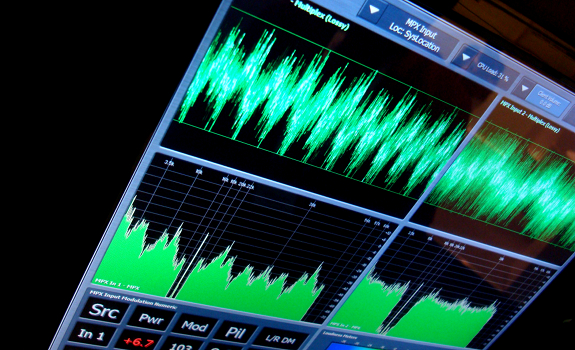
Every audio signal processor has a distinctive frequency profile, which is why the Omnia.9 frequency characteristic on the left side looks different than that of a competitor’s flagship product on the right side (photo: Thomas Giger)
Reverse clipping and distortion
“It’s hard to find current music that doesn’t have clipping nowadays”, Claesson says about the common problem of over-processed songs. Omnia tries to neutralize distortion with a de-clipper and a multiband expander, which together form the Undo function – like a ‘Ctrl Z’ for sine waves of which the top has been cut off in the music industry’s loudness war and now has the form of a square, rather than a round wave. We’re listening to a completely distorted heavy metal song that, after we press ‘Undo’, sounds much cleaner indeed. The Omnia.9 remote control screen shows that the original, heavily compressed waveform – as it was ‘mastered’ by the record company – is reshaped. It looks like all clipping has disappeared, and even more importantly: that same track actually sounds much more powerful now.
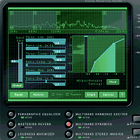 Replace clipping by dynamics
Replace clipping by dynamics
The Undo function algorithm is able to figure out which part of the signal is missing, and then re-create it, based on frequencies that came before and after. The multiband expander ‘sees’ where audio is dynamic, and where it’s not – in which case it will be adjusted. “Without this”, Leif Claesson continues, “I wouldn’t be able to listen to music. At least not any audio mastering after 2002, when things started to get really hay wired.”
Review output after processing
Omnia.9 includes a complete modulation analyzer. “It allows you to compare what the signal processor sends to your transmitter to what you get back from the transmitter over the air, which ideally should look the same. It also helps you to see which processor your competition is using.” Claesson puts the FM broadcasting frequency chart of an Omnia.9 besides that of a competitors’ flagship product. “It’s very easy to tell which processor is which.” He demonstrates that the Omnia audio processor’s frequency graph (big picture above) “goes down very sharply and protects the pilot tone” and that the other sound processor’s fingerprint shows “composite clipping artifacts around the pilot”. This monitor tool also allows him to assist clients remotely. “You can connect the composite output of a tuner to the Omnia.9’s composite input. If a station needs help with, for example, beating their competition’s sound, I can dial in from wherever I am to see and hear what they’re doing locally.”
“Airplanes have never crashed because of radio
in the two loudest cities in the world”

Introducing the MPX Power standard in highly-competitive radio markets like New York and Paris could make the listener a winner of the radio loudness war, as it would make clipping useless (photos: NYC42, HD Wallpaper)
Introduce market-wide MPX Power
You work with many stations around the world. Do you see global audio processing trends?
“In countries that have MPX Power, the loudness wars have ended. ITU-R BS.412 is a very interesting standard for limiting the modulation and loudness in radio.” He explains that in the past, radio stations only had to limit their peak modulation to +/- 75 kHz from the assigned FM frequency. It was tempting to crank up the processor and continuously stay at 75 kHz in order to sound louder than others, until broadcast engineers found an interesting way to put this on the agenda. “They said: with this over-modulation our planes may crash! It was that level of a discussion… Airplanes have never crashed because of radio in neither New York nor Paris, which are the two loudest cities in the world.” This led to the introduction of MPX Power in several countries, where broadcasters now have to limit the average modulation: “You can afford to have some peaks, but not to be loud all the time, as you would then go over the power limit. So, there’s no point in clipping the audio anymore.”
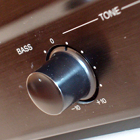 Keep enough bass & treble
Keep enough bass & treble
But there is one catch: “Modulation power is being measured at the composite signal, meaning after stereo coding and after pre-emphasis. Unfortunately it doesn’t match sound processing to how we humans hear audio at all. Bass is using up a lot of power, and so does treble, due to pre-emphasis. Some stations have tried to be louder, even with MPX Power regulation, by cutting out their bass and treble.”
Find bass & energy balance
That’s sounds horrible! Predominantly mid, that’s close to a phone line…
“Exactly. The Omnia.9 has ways to manage this, like a feature that makes the bass punchier without using up too much energy. It’s kind of a simple trick: a matter of adjusting the side-chain delay on a compressor that only handles bass. It allows you to have a nice, punchy, natural sound at a reasonable volume, even with MPX Power limitations.” The company is now building a complementary device that could boost its flagship processor’s market share in Europe; a separate stereo generator. “Omnia.9 has its own stereo generator, but it’s inside the unit and you probably want that at the station; not at the transmitter site.” The Omnia.9 SG will be released at the NAB 2014. “It will also include the psychoacoustic distortion-masking composite clipper, which is part of the key to a clean and loud sound.”
“Loudness is only important
during the first 2 seconds”
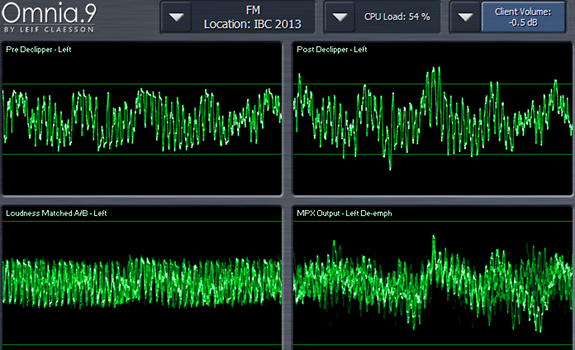
Leif Claesson advises not to maximize loudness, as listeners will adjust the volume level anyway, and to declip distorted music through the Omnia.9 Undo function to get an MPX Power proof signal (screenshot: Omnia)
Avoid adding (much) pre-processing
Do you have 3 takeaways for radio professionals who are looking for a great on-air sound?
1. “Do not compress, limit or equalize audio before it gets into the sound processor, so the Undo function of the Omnia.9 has a chance to do its job. There are many tools in the unit to create your signature sound, such as equalization and compression. If you add pre-processing, the de-clipper can’t function and you’re still left with distortion. Keep the audio signal that goes into the unit as clean as possible. Don’t worry about the signal sometimes being quiet. The audio input has 24-bits of resolution, meaning: the noise floor is at -144 dB. So even an extremely quiet signal can be brought up with no audible noise penalty.”
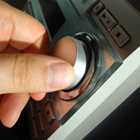 Forget loudness, remember TSL
Forget loudness, remember TSL
2. “Loudness is only important during the first 2 seconds. The first thing people do after they find a station that they want to listen to, is adjusting the volume”, Claesson knows. “Don’t kill your sound over that last dB of loudness. It’s not worth it. People will get tired of listening to the radio, without even knowing why. They’ll turn it off and listen to their iPod instead.” (A comfortable sound can help you to increase your Time Spent Listening.)
Use top-quality sound files
3. “Hard drives are cheap. Don’t use MP3; use WAV or FLAC files. I don’t know if FLAC is supported by most radio automation systems, but it’s a lossless compression – like putting your audio files through a ZIP, except that it’s optimized for audio. It’s bit for bit accurate and a nice archive format. Otherwise, use WAV.”
“There’s nothing more differentiating for me as
to have someone turn it up past the breaking point”

Leif Claesson, here in front of the Omnia / Telos Alliance IBC 2013 booth, likes radio stations with a powerful on-air sound – within (MPX Power) limits of what’s comfortable to hear during a long period of time (photo: Thomas Giger)
Ignore loudness war temptations
You’ve heard many stations in many markets. Which ones have a really good sound, in your opinion – whether they have an Omnia or not?
“Radio ABC in Denmark does have an Omnia.9 and they’ve set up everything correctly, so if you listen to their stream online I think you’ll like the sound. Then there’s COOLcelsius 91.5° in Bangkok who also have a very good-sounding 64 kB AAC+ stream.”
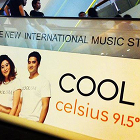 Optimize your music playlist
Optimize your music playlist
That’s the most original station name I’ve come across in a long time!
“Yes! They also have a second channel, COOLfahrenheit 93°, with Thai Pop. COOLfahrenheit still uses an Omnia.6, but COOLcelsius has an Omnia.9. They also have a well-programmed station; definitely one of my favorites – and I’m always listening online”, says Claesson. He resides in Thailand, but has airports as a second home as he travels to clients a lot.
Have a listener-friendly sound
Refreshing examples. Most radio guys would have mentioned Z100, NRJ or Capital FM.
“There’s nothing more differentiating for me as an audio engineer than to have made a unit which allows you to be clean and loud, and then to have someone turn it up past the breaking point anyway. So I can’t recommend any of those, but I can recommend Radio ABC and COOLcelsius. They do a good job.”





Hello,
How do i get a signature sound and achieve clean and loud sound by using Omnia 7
Hi Sergio!
Sorry for a late reply; it’s been very busy.
I’ve just emailed you with a contact to a friend of mine who works at Omnia; he’ll be able to help you. Let me know how it works out!
Cheers,
Thomas
Hi, we have Omnia 9, but the sound have a time delay (5 seconds) between the input and output, it’s possible to correct it?
Hi Kabir,
Thanks for reaching out!
Nice to hear from you, and to receive a message from Bangladesh, loud and clear!
Thank you for your question as well, which I have forwarded to our contacts at Omnia.
I am sure they will be able to help you get a loud and clear sound :-).
I wish you a great week!
Cheers from Holland,
Thomas
We have Omnia 9, but the sound quality is not better yet, running the default preset Plutonium HD.
I have listened to your reference link of radioabc.dk. I think this sound quality is fulfilling our requirements.
How can I get this ABC preset, and how can I input this preset into our Omnia 9? Or how can I improve our sound quality ?
Please help me.
Kabir
Hi Senthil,
Thanks for your question! The answer depends on many things, including your market (how is the average station in your market sounding), format (how is the average hour on your station sounding), and your vision (how do you feel your brand should come across).
You already answered the latter by saying that you’re looking for a clean and undistorted sound, but the exact adjustments can best be made on site by an audio processing consultant in your region (or, as you live in a huge country, over the Internet).
I have passed on your contact info to the Telos Alliance. They will be able to guide you to a local expert.
Thanks for reading Radio))) ILOVEIT, and have a great radio day!
Cheers,
Thomas
Hi, pls let me know how to get the clean and undistorted sound for my FM station. What are things I have to look for, what adjustments should be made? I am using Omnia 9.
Hi Bob,
Thanks for your suggestion!
We’ll definitely consider that for a new post in this series about on-air sound processing for radio.
Cheers,
Thomas
Hope to see one of these on the Wheatstone Vorsis processors.
It’d be interesting to see your comparison of their very different approach to this, and how you think the results stack up.
Bob
Hi Antal,
Thanks for your comment. Interesting research about young people’s perception that loud = better.
Could a possible explanation be that today’s listeners are simply conditioned that compressed audio is the norm, exactly because they have grown up with stations that sound like this – and YouTube videos and downloaded MP3s as their main point of reference?
Older listeners might come from the generation of hi-fi sets, vinyl records, and on-air processing before the loudness war. That could explain why they have different listener expectations of radio, and why an AC Gold station is much better off with a warm and dynamic sound.
Cheers,
Thomas
Hello,
Leif is an amazing engineer, and the UNDO process has been THE innovation for many years back on the audio broadcast processing field, in my opinion.
The timing couldn’t have been more perfect: with the age of digital broadcasting the – over-compressing resulted – loudness is not as important anymore than the overall quality. Somehow this new feature is not spreading too quickly.
The “loudness is important only for 2 seconds” can be literally true, but… according to some of our most recent research, 60+% of young people believe that a “louder” station is likely a better one. Psychoacoustics! Maybe this is why stations are not giving up loudness so easily.
On the other hand: older listeners prefer a smooth, balanced sound – the sound of the 80s, as they describe it. In the long run, BOTH demographics selected the good quality (not over-compressed) sound. This is why I prefer to fine-tune broadcast processors in the smooth direction – however, this is market and format (target audience) dependant!
In the ancient times, there were (audio) engineers around the recording companies using gadgets with wisdom. Nowadays, the one man show / DJ ‘studios’ are spouting out the majority of music played in radio. These over-processed, square-form electronic pieces have been raising the bar of the loudness war.
Our job at the very end on the broadcast side is to eliminate their lack of knowledge, failures and retouch the sound. Omnia and Leif try to help us with the UNDO process and their other innovations.
Fingers crossed,
Antal